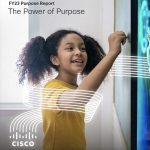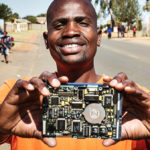This post is guest authored by Bryan Wiggins, Supplier Diversity Leader, Global Procurement Services at Cisco. He is an Execution Owner of Cisco’s Social Justice Action 7, Supplier Engagement. Bryan has a nearly 20-year career with Cisco and is a US Army Veteran.

Seven years ago, I heard Cisco’s chief procurement officer, Alexandra Lopez, was making a visit to Hampton Roads, Virginia, to meet with businesses in an historically underutilized business zone or “HUBZone.” HUBZones are created to provide opportunities to small businesses disadvantaged by their location in urban and rural communities. I lived within driving distance, so I asked if I could join her. I had no idea the trip would be a pivotal moment in my career and would result in my role supporting Cisco’s social justice efforts and how we can make Cisco’s spending with third-party suppliers more equitable.
We met with one small business in the HUBZone performing back-office finance work for a major web company. They tapped into a richly capable but geographically disadvantaged talent base, military spouses, 30% of whom were unemployed or underemployed. A small company, they brought innovation and agility to their work, pioneering remote work at a time few were. When it was time to relocate, if the employee was performing well, the company would send them off to their spouse’s next duty assignment — anywhere in the world — with a laptop and their job.
When I heard this, I imagined what such an opportunity would have meant to me and my wife in the early years of our careers. Prior to working at Cisco, I was a helicopter pilot in the US Army. Like many service members, I had a spouse who left a promising career of her own to support my military career. I knew at that moment I wanted to be a part of uncovering unrealized business value in diverse suppliers, which have been traditionally overlooked or excluded. I had heard that Alexandra was planning to create a new supplier diversity program within Cisco’s Global Procurement Services organization, so I took the opportunity to tell her I wanted to work on it. This was the beginning of my journey.
A history of supplier diversity
Cisco spends more than $5 billion annually in controllable indirect spend in the US. Over the last 6 years we have:
- Engaged with over 240 diverse owned companies
- Enabled 27 diverse suppliers to achieve Cisco Preferred status
- Established new supplier diversity programs in the UK and India
- Welcomed 56 diverse suppliers into our executive sponsorship programs globally
- Expanded into broader social justice areas like Sustainability and Contingent Workforce Diversity
Actions to drive supplier diversity

In 2020 Cisco launched its Social Justice Beliefs and 12 Actions. Action 7, Supplier Engagement, put a spotlight on the supplier diversity programs Cisco has had in place for years, accelerating them and expanding our commitment in new ways.
As a result, we have made concrete progress to address social justice with respect to our supplier community:
- Competitive sourcing bids must now include at least one qualified diverse supplier where at least one is available. Over the last four quarters, 94% of all competitive sourcing bids included at least one diverse supplier. For bids where a diverse supplier participated, they won the bid at least 25% of the time. As a result, over the last two quarters, we have seen spend with diverse suppliers increase by nearly $40 million.
- Preferred suppliers are required to report annually on the full spectrum of diversity of their US workforce. Because a significant portion of Cisco’s spending is on people, this is one of the most important metrics we can track. In FY21, we received workforce diversity reports from 100% of our FY20 preferred suppliers who had US workers in FY21.
- A sponsorship program is underway for 10 African American/Black-owned suppliers in the US.
- The conscious culture training created for Cisco employees will be made available to Cisco’s preferred suppliers.
Recently, our procurement category leaders and business functions finalized their diverse supplier spend targets, and they have begun to execute on their plans. As contracts come up for bid, we are working these targets into our pipeline. By the end of 2023, we expect to double our percentage spend with diverse suppliers.
It’s not about giving business to diverse suppliers — it’s about opportunities for diverse suppliers to compete being built into the DNA of our business.
Sponsorship is a key driver of success
Our executive supplier sponsorship program has been a powerful tool to advance social justice in procurement. It pairs diverse suppliers with Cisco executives for regular meetings during which they learn more about Cisco’s priorities and receive coaching and feedback. Additionally, these suppliers are invited to monthly curriculum meetings, speaker events, and networking opportunities.
With the 56 suppliers that have completed or are currently enrolled in our sponsorship programs, we have seen some encouraging trends emerge. First, we routinely see sponsorship participants increase their Cisco business—which is not something we promise them when they join the program. We also see their supplier performance increase, where their scores are consistently higher than preferred suppliers, while concurrently lowering their risk — a scoring that is sometimes weighted against smaller companies.
“Our executive supplier sponsorship program has been a
powerful tool to advance social justice in procurement.”
A drive to succeed
In my years working in Global Procurement Services, I have seen over and over that our diverse suppliers tend to be smaller companies, which often have a drive to succeed that translates into greater innovation, agility, flexibility, and creativity.
I believe deeply in the benefits of supplier diversity. If I did not, I never would have turned to Alexandra on that day and asked to be put in this role. Through Action 7, we are not only continuing our commitment to supplier diversity, but we are also expanding and already seeing the tangible results of our actions — powering an inclusive future for all.


Great article Bryan!